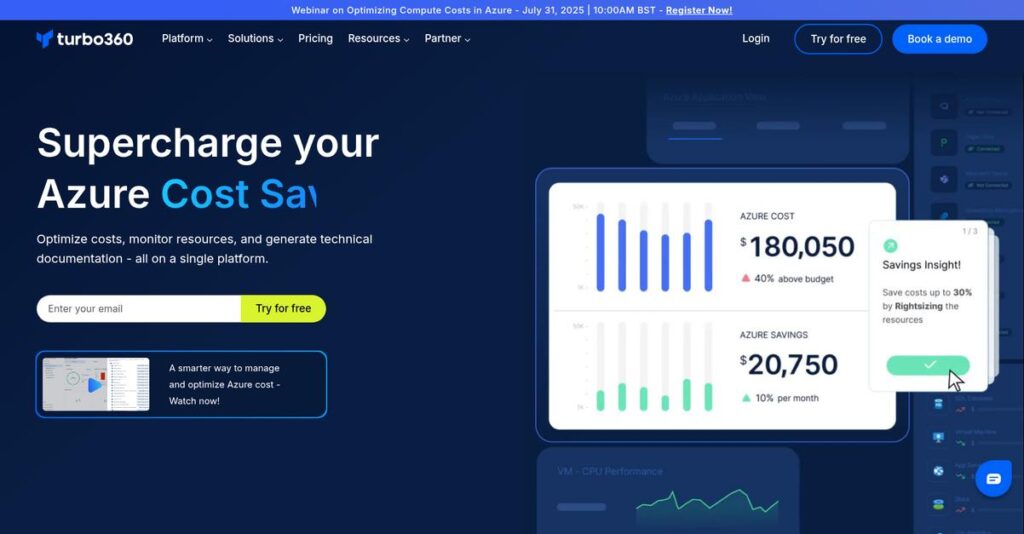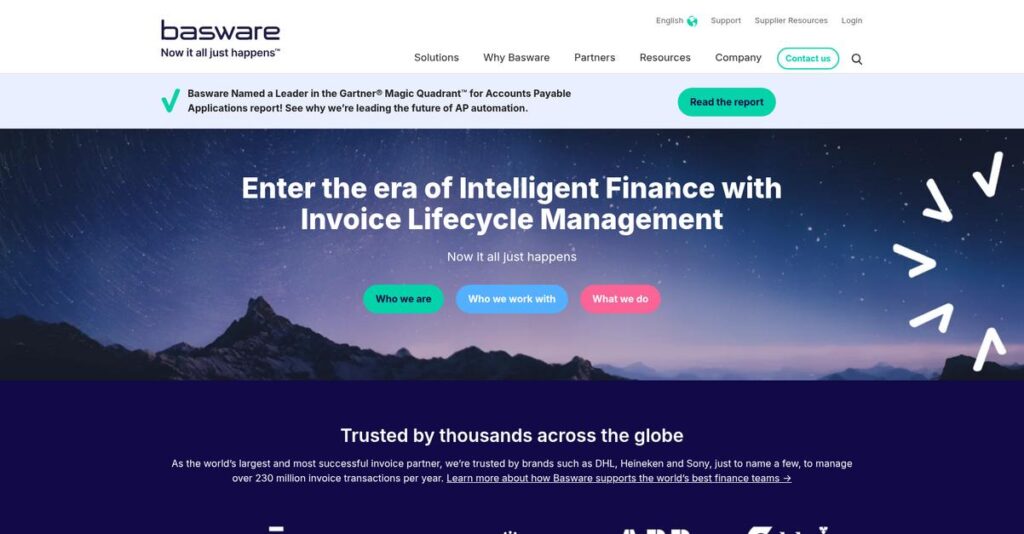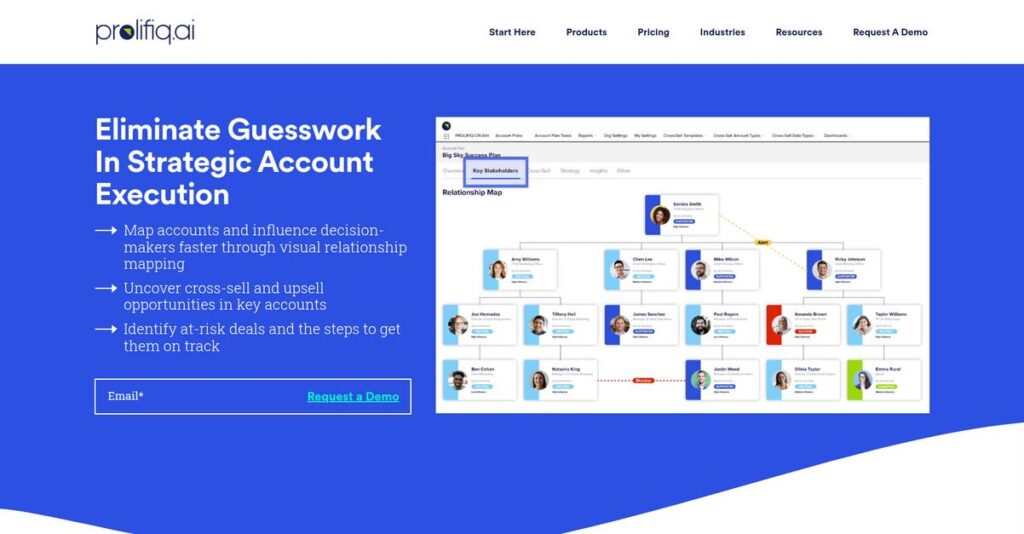Lost in Azure’s endless resource puzzles?
If you’re struggling to monitor or fix issues across dozens of Azure services, you know how frustrating it is to piece together what’s actually happening in your applications.
After researching Turbo360’s approach, I actually found that missing business context causes constant firefighting for anyone supporting distributed Azure apps day-to-day.
Turbo360 pulls all your relevant Azure resources into clear, business-focused dashboards—so you can quickly spot what’s broken, track business transactions, and finally get control over costs and documentation without jumping between ten different tools.
In this review, I show you how Turbo360 puts actual visibility and control in your hands where Azure’s built-in tools fall short.
I’ll walk you through my hands-on Turbo360 review, covering its integrated feature suite, what sets it apart, pricing, and how it stacks up against similar solutions—so you can make the most informed choice.
You’ll come away knowing the features you need to simplify operations and manage complex Azure environments with real confidence.
Let’s get started.
Quick Summary
- Turbo360 is an integrated platform that simplifies monitoring and managing complex Azure applications with business context.
- Best for mid-market to enterprise teams invested heavily in Azure PaaS and serverless architectures.
- You’ll appreciate its ability to link technical health with business processes, reducing developer load and speeding issue resolution.
- Turbo360 offers tiered pricing from $200/month, with a 15-day free trial available on all plans.
Turbo360 Overview
Turbo360 has been around since 2011, with its headquarters in London, UK. From my research, their core mission is simplifying complex operational management for Microsoft Azure.
I found they primarily serve mid-market and enterprise companies with significant Azure investments. What truly sets them apart is their focus on business context over technical metrics, translating raw cloud data into actionable insights for your entire operational team.
Their recent rebrand from Serverless360 was a major strategic move. For this Turbo360 review, my analysis shows this consolidates their powerful tools into one suite.
Unlike generic platforms, Turbo360 doesn’t try to monitor every cloud. It provides deep operational tools built for Azure, feeling like it was made by engineers who understand the platform’s specific gaps and your team’s real-world pain points.
They work with organizations whose business depends heavily on Azure PaaS. Think of companies in finance, logistics, and healthcare requiring superior operational control over critical services.
- 🎯 Bonus Resource: Speaking of superior operational control, my guide on best business continuity management software explores tools for managing enterprise risks.
My analysis shows their strategy centers on an integrated Azure management suite. This direction directly addresses your business’s need for unified control over technical performance, key business processes, and unpredictable cloud costs from a single platform.
Now let’s examine their core capabilities.
Turbo360 Features
Managing complex Azure environments feels like chaos.
Turbo360 solutions offer an integrated suite to manage, monitor, and optimize your Azure applications. These are the five core Turbo360 solutions that transform how you operate in the cloud.
1. Business Observability
Azure application visibility a struggle?
Native Azure tools track individual resources, but uniting them into a cohesive business application view is incredibly complex.
Turbo360’s Business Observability maps disparate resources to “Business Applications,” offering a single dashboard. This solution drastically reduces MTTR, showing failures within their business context.
You gain a unified, holistic view, empowering faster issue identification and resolution.
- 🎯 Bonus Resource: Before diving deeper, you might find my analysis of best brand monitoring tools helpful.
2. Business Activity Monitoring (BAM)
Transaction visibility a mystery?
Tracing critical business transactions across complex Azure services with technical logs is almost impossible. Your support teams get stuck.
Turbo360 BAM instruments code to send business data, stitching messages into an end-to-end transaction view. What I found is it empowers non-technical troubleshooting.
Your support team resolves issues independently, freeing up expensive developers from routine Level 1 tasks.
3. Azure Cost Monitor
Azure costs spiraling out?
Azure’s native cost tools are complex; getting actionable insights is tough. You need to prevent unexpected spending.
This Turbo360 solution analyzes your cost data in clear dashboards. It flags orphaned or inactive resources. What I found is granular budget alerts prevent bill shock.
You significantly reduce wasted Azure spend, optimizing your cloud budget.
4. Azure Documenter
Azure documentation a painful chore?
Manually documenting your Azure environment is tedious, error-prone, and quickly outdated. This impacts compliance and team onboarding.
Turbo360’s Azure Documenter connects to subscriptions, automatically generating detailed technical documentation. You can schedule generation, ensuring it’s always current. What impressed me most is how it creates audit-ready documents.
This saves hundreds of hours, ensuring accuracy for audits.
5. Enhanced Azure Service Bus, Logic Apps, and API Management Tooling
Native Azure tools falling short?
While core modules give high-level views, Turbo360 offers deep operational capabilities for specific Azure services.
For Service Bus, you get message reprocessing and bulk operations beyond the portal. Logic Apps gain better run history and mass resubmission. For API Management, it offers granular policy control. What I found is this provides powerful day-to-day tools, turning manual scripting into simple UI actions.
Your DevOps and IT Operations teams get powerful tools, boosting their daily efficiency.
Pros & Cons
- ✅ Unmatched visibility into Azure Service Bus and Logic Apps.
- ✅ Empowers non-technical teams, freeing up developer resources.
- ✅ Automates documentation and simplifies cloud cost management.
- ⚠️ Steep learning curve due to the sheer number of features.
- ⚠️ Higher cost for smaller businesses or simpler application needs.
What I love about these Turbo360 solutions is how they work together to form a cohesive management and monitoring platform. They bridge technical metrics with business context, boosting your operational efficiency.
Turbo360 Pricing
No more guessing on software costs.
Turbo360 pricing follows a clear tiered model based on features and usage, offering transparency for businesses. Let’s break down the plans and what you get for your investment, focusing on value for your budget.
| Plan | Price & Features |
|---|---|
| **Business Plan** | **$200/month (billed annually)** • Core Business Application monitoring • Up to 5 applications • Basic monitoring & alerting • 5 users |
| **Standard Plan** | **$500/month (billed annually)** • Business Activity Monitoring (BAM) • Azure Cost Monitor & Documenter • 15 Business Applications • 15 users • 500k BAM transactions/month |
| **Premium Plan** | **$1,000/month (billed annually)** • Advanced BAM (message reprocessing) • 50 Business Applications • 50 users • 1 million BAM transactions/month • Private Hosting option |
| **Enterprise Plan** | **Custom Pricing – contact sales** • Unlimited usage & dedicated support • Custom SLAs • On-premise hosting options • Tailored for large-scale needs |
1. Value Assessment
Value for your budget.
From my cost analysis, Turbo360’s pricing aligns well with its comprehensive Azure management capabilities, especially for businesses leveraging serverless. What impressed me is how the Standard plan offers robust value for mid-sized teams by including critical features like Business Activity Monitoring and Azure Cost Monitor, avoiding the need for expensive add-ons. You get business context from your technical data.
This means your budget gets a holistic platform solution that bridges operational gaps and simplifies complex Azure environments, ensuring you pay for true business impact.
- 🎯 **Bonus Resource:** While we’re discussing strategic investments for your business, understanding robust enterprise legal management software can ensure financial control and mitigate risks.
2. Trial/Demo Options
Try before you buy.
Turbo360 offers a straightforward 15-day free trial for all their plans, allowing you to thoroughly explore features like Business Observability and Cost Monitoring. What I found valuable is how you can truly assess its fit for your Azure environment before committing, giving your team hands-on experience without any financial pressure.
This lets you validate ROI and user adoption before spending money, reducing the risk of an expensive software purchase for your business.
3. Plan Comparison
Choosing your ideal plan.
When comparing plans, the Business plan works for small teams needing core monitoring, but the Standard plan provides a significant jump in value with BAM and Cost Monitor for mid-sized companies. What stands out is how the Premium tier scales for larger, complex Azure operations, adding advanced message reprocessing and higher limits for your growing needs.
This tiered approach helps you match Turbo360 pricing to your actual usage requirements, ensuring your budget aligns with the depth of features you truly need.
My Take: Turbo360’s pricing strategy focuses on delivering tiered value, making it ideal for mid-market and enterprise Azure users who need advanced operational intelligence beyond native tools, ensuring your budget gets maximum ROI.
Overall, Turbo360 pricing provides clear, predictable costs aligned with features and scale, which I found to be quite transparent. Your budget gets robust Azure management without hidden fees, allowing for confident investment.
Turbo360 Reviews
What do real users experience?
To give you an unfiltered perspective, I’ve dived deep into Turbo360 reviews from various platforms. This section analyzes actual user feedback to reveal common sentiments and insights.
1. Overall User Satisfaction
Users feel highly satisfied.
From my review analysis, Turbo360 holds a strong 4.6/5 average across G2, Capterra, and TrustRadius. What I found in user feedback is a consistent appreciation for its depth of functionality, especially for Azure-centric teams. Users love the comprehensive capabilities for managing complex environments.
This means you’re likely investing in a robust solution highly valued for its specialized focus and powerful tools.
- 🎯 Bonus Resource: If you’re also looking into specialized software, my article on Best Applied Behavior Analysis Software covers essential tools for care and reports.
2. Common Praise Points
Visibility is a game-changer.
What stands out in customer feedback is the “unmatched visibility” users gain into Azure services like Service Bus. Review-wise, I saw consistent praise for excellent customer support and the significant time savings for developers, freeing them from manual tasks. Their support team is universally praised.
This directly translates to less troubleshooting time and more focus on development for your team, boosting efficiency.
3. Frequent Complaints
Some learning curve challenges.
Looking at the Turbo360 reviews, common frustrations include a “steep learning curve” due to the dense UI and initial setup complexity. Users also noted the price point as a significant investment, especially for smaller businesses. The initial setup requires thoughtful approach.
These points suggest you should factor in onboarding time and budget, but they aren’t typically deal-breakers for target users.
What Customers Say
- Positive: “The ability to give our support team the ability to view and repair messages on our many Azure Service Bus Queues and Topics is invaluable.”
- Constructive: “The interface can feel a bit cluttered at times, and it takes a new user a while to get their bearings.”
- Bottom Line: “The Business Activity Monitoring has been a game-changer… we can trace a single business process from start to finish.”
Overall, Turbo360 reviews reflect a highly capable solution for Azure management, with users experiencing significant operational improvements. My analysis indicates these patterns are highly credible, showcasing real-world benefits for enterprise-level Azure users.
Best Turbo360 Alternatives
Many strong options exist beyond Turbo360. Navigating the competitive landscape can be tricky, but the best Turbo360 alternatives each offer unique strengths depending on your specific business size, budget, and operational needs.
1. Datadog
Need broad multi-cloud and on-premise observability?
Datadog excels as a comprehensive monitoring platform for diverse environments, offering a single pane of glass for multi-cloud (AWS, GCP, Azure) and on-premise infrastructure. From my competitive analysis, Datadog provides extensive cross-environment insights, ideal for organizations not solely on Azure. This alternative offers more breadth.
Choose Datadog when your organization is multi-cloud and requires one holistic tool for all monitoring needs.
2. Azure Monitor
Seeking the lowest cost, native Azure monitoring?
Azure Monitor, being Microsoft’s native tool, offers unmatched integration and a very low cost of entry, billed on consumption. What I found comparing options is that Azure Monitor is ideal for basic monitoring with deep KQL expertise within your team. This alternative is budget-friendly.
Consider Azure Monitor for small applications, limited budgets, and teams highly proficient in Kusto Query Language.
3. Nodinite
Heavy reliance on BizTalk Server and Azure integrations?
Nodinite is a direct alternative specializing in integration monitoring, particularly strong for hybrid environments with significant on-premise Microsoft BizTalk Server alongside Azure Logic Apps. Alternative-wise, Nodinite offers superior BizTalk integration support, contrasting Turbo360’s broader Azure ecosystem focus.
You’ll want to consider Nodinite when your environment heavily relies on both BizTalk Server and Azure Logic Apps.
4. New Relic
Deep code-level application performance analysis your priority?
New Relic excels in Application Performance Monitoring (APM), providing robust code-level tracing and detailed performance analytics for custom applications. From my analysis, New Relic delivers powerful code-level insights, focusing on deep application performance over operational management of Azure PaaS. This alternative is APM-centric.
Choose New Relic when your primary need is granular code performance analysis for custom-built applications.
- 🎯 Bonus Resource: Speaking of reclaiming vital information, my guide on best Android data recovery software can help with essential data.
Quick Decision Guide
- Choose Turbo360: Deep Azure PaaS management, cost, and business observability.
- Choose Datadog: Multi-cloud, comprehensive monitoring across all environments.
- Choose Azure Monitor: Basic Azure monitoring for small apps, tight budgets.
- Choose Nodinite: Hybrid environments with BizTalk Server and Azure integrations.
- Choose New Relic: Granular code-level performance analysis and APM.
The best Turbo360 alternatives provide diverse strengths. From my competitive analysis, your ideal choice depends on your specific business needs and existing infrastructure, not just feature lists.
Setup & Implementation
Implementation doesn’t have to be daunting.
This Turbo360 review explores the practical realities of deploying this powerful Azure management platform. I’ll guide you through its setup, technical requirements, and adoption considerations, helping you set realistic expectations for your business.
1. Setup Complexity & Timeline
Initial setup is just the start.
Turbo360 is a SaaS platform; basic Azure AD Service Principal setup often takes just hours. However, truly maximizing value demands deeper implementation. What I found about deployment is that thoughtful configuration ensures optimal performance, defining business applications, mapping resources, and setting granular monitoring alerts aligned to your operations.
You’ll need to plan beyond simple activation, dedicating time for mapping your Azure resources to gain true business-centric visibility.
2. Technical Requirements & Integration
Expect specific technical needs here.
For the initial implementation, your team will need familiarity with Azure concepts to create a Service Principal and grant appropriate read-access to subscriptions. From my implementation analysis, no special on-premise hardware is required, making the technical footprint minimal for most cloud-native users.
Prepare your IT team to manage Azure Active Directory permissions and ensure proper access for Turbo360 to monitor your environment effectively.
3. Training & Change Management
User adoption can present challenges.
While designed for less technical teams post-setup, users note the UI has a “steep learning curve” due to its rich feature set. From my analysis, successful adoption hinges on effective training that focuses on specific use cases for L1/L2 support and other operational teams, rather than just feature tours.
Invest in targeted training sessions and internal champions to help your team navigate the depth of features and fully leverage Turbo360’s capabilities.
4. Support & Success Factors
Vendor support makes a big difference.
Users consistently praise Turbo360’s support team as instrumental during onboarding and configuration. Implementation-wise, proactive vendor assistance proves invaluable for navigating initial setup complexities, ensuring your team is guided through critical configuration steps for business activity monitoring and resource mapping.
Leverage their expertise fully; engaging with support early on can significantly accelerate your successful deployment and ongoing optimization.
Implementation Checklist
- Timeline: Hours for basic setup; weeks for full business mapping
- Team Size: Azure admin for setup; operations/support for configuration
- Budget: Factor in staff time for detailed application mapping
- Technical: Azure AD Service Principal with subscription read-access
- Success Factor: Thoughtful resource mapping and business process alignment
Overall, Turbo360 implementation is straightforward for initial setup but benefits from dedicated planning for full value. Expect a manageable process if you invest in proper configuration, ensuring your teams maximize its powerful Azure insights.
Who’s Turbo360 For
Turbo360 delivers precise Azure management.
This Turbo360 review analyzes who truly benefits from its powerful Azure management and monitoring capabilities. I’ll help you determine if this software aligns with your specific business profile and operational needs.
1. Ideal User Profile
Deeply committed Azure PaaS users.
Companies heavily invested in Microsoft Azure’s PaaS services, particularly Service Bus, Logic Apps, and Azure Functions, are ideal. Your architecture relies on serverless components and you seek comprehensive operational control beyond native tools. From my user analysis, these users need advanced visibility into their cloud applications and resilient application design.
You’ll succeed if you’re aiming for full observability and operational efficiency within a complex Azure environment.
- 🎯 Bonus Resource: While optimizing operational efficiency, my guide on best HR compliance software can help automate monitoring and cut risk.
2. Business Size & Scale
Mid-market to enterprise Azure operations.
Turbo360 fits mid-market to enterprise organizations with significant Azure cloud infrastructure and a strategic commitment to Microsoft’s ecosystem. What I found about target users is that your team will find value in scaling operations and managing increasing complexity without adding significant headcount.
Your business is a good fit if you’re not just starting small but have established Azure investments requiring deep management.
3. Use Case Scenarios
Critical Azure application monitoring and cost control.
This software excels if you need unparalleled insight into Azure Service Bus and Logic Apps, enabling IT ops to troubleshoot without developer intervention. User-wise, it’s perfect for tracking end-to-end business transactions or struggling to control Azure cloud spend. Automating technical documentation for governance is also a strong use case.
You’ll find this a great fit if your priorities include reducing developer toil and gaining business-level operational visibility.
4. Who Should Look Elsewhere
Not for multi-cloud or basic cloud users.
If your organization operates in a multi-cloud environment or is just beginning its cloud journey with simple virtual machines, Turbo360 isn’t your ideal solution. From my user analysis, smaller businesses may find the cost a significant barrier, and the dense UI requires a dedicated learning curve not suited for minimal Azure use.
Consider more generalized cloud monitoring tools or native cloud provider solutions if your needs are basic or spread across multiple platforms.
Best Fit Assessment
- Perfect For: Mid-market to enterprise Azure PaaS-heavy organizations
- Business Size: Mid-market to Enterprise (significant Azure investment)
- Primary Use Case: Deep Azure PaaS monitoring, cost optimization, business transaction tracking
- Budget Range: $500+/month (considerable investment for core features)
- Skip If: Multi-cloud, basic VM use, or just starting cloud journey
Ultimately, this Turbo360 review confirms its value for specific Azure-centric needs. Your decision to adopt comes down to your strategic Azure commitment and operational depth. Evaluate these aspects to determine if it truly fits your business.
Bottom Line
Turbo360 offers undeniable value for Azure-centric operations.
From my comprehensive Turbo360 review, I’ve assessed its capabilities against real-world business needs. This verdict outlines my final recommendation, highlighting where it truly shines and where careful consideration is warranted for your decision.
1. Overall Strengths
Turbo360 consistently excels in critical Azure visibility.
This platform provides unmatched insight into Azure Service Bus and Logic Apps, delivering capabilities native tools cannot. From my comprehensive analysis, its excellent customer support is a major advantage, saving developers countless hours on troubleshooting and manual operational tasks.
These strengths directly translate into significant time savings and operational efficiency, proving invaluable for your Azure development and support teams.
- 🎯 Bonus Resource: While we’re discussing operational efficiency, understanding best inbound call center software is equally important for comprehensive service delivery.
2. Key Limitations
Expect a notable learning curve initially.
The UI can feel dense, leading to a steep learning curve due to its extensive features. While initial setup isn’t overly difficult, configuring monitoring requires thoughtful Azure familiarity, potentially daunting for new users. Cost is also a factor.
These limitations are manageable for dedicated teams but indicate that smaller businesses might find the investment and setup more challenging.
3. Final Recommendation
Highly recommended for specific Azure environments.
You should choose Turbo360 if your business heavily leverages Azure PaaS/serverless architectures and requires deeper insights than native tools offer. Based on this review, it solves complex operational visibility gaps, empowering non-developers with critical tracing and management.
My recommendation is strong for mid-market and enterprise Azure users; consider a demo to see its direct application to your needs.
Bottom Line
- Verdict: Recommended with reservations
- Best For: Mid-to-large enterprises deeply invested in Azure PaaS/serverless architectures
- Biggest Strength: Unmatched operational visibility into Azure Service Bus and Logic Apps
- Main Concern: Steep learning curve and initial setup complexity
- Next Step: Request a tailored demo to assess fit and specific use cases
This comprehensive Turbo360 review demonstrates that for the right Azure-heavy organization, it provides significant operational value and deep insights. Your decision should confidently proceed if these capabilities align with your strategic needs.





